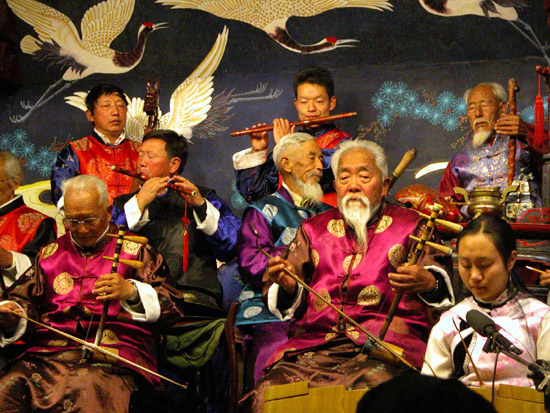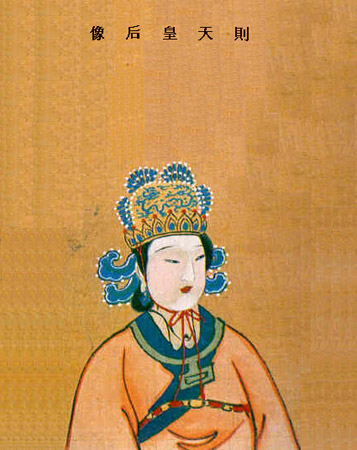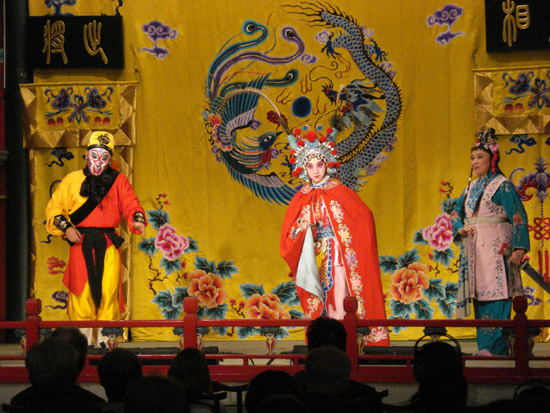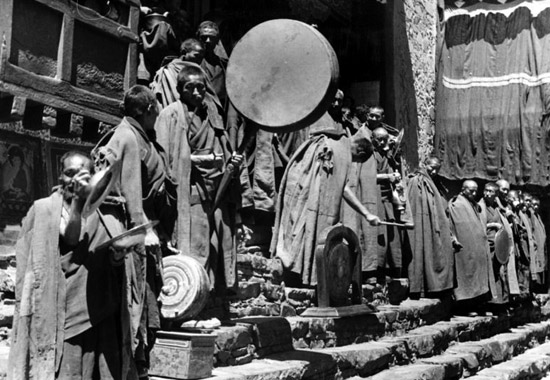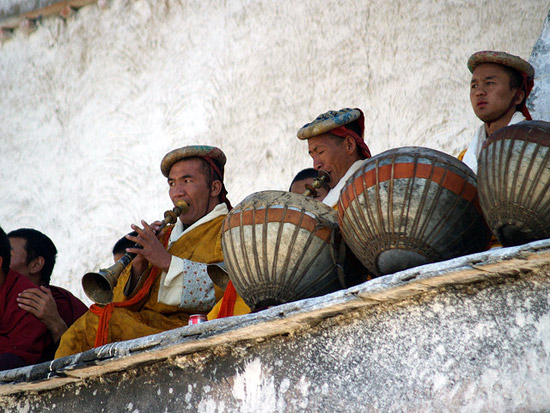Music: Music Overview
Like its landscape of thick forests, vast steppes, undulating deserts, and high mountain ranges, China's population is diverse. The PRC officially recognizes 56 subcultures, all of which are reflected in the vast scope of the country's music. From the religious music for shamanistic and animistic practices, Taoist and Confucian rituals, and Buddhist temple ceremonies, to the regional folk music for work, weddings, festivals, and other life activities, to the elegant classical music that developed in the Chinese courts, to the revolutionary songs that highlighted the rise of Communism, to the popular and modern music that came with increasing Western influences, the music of China traces the social, cultural, and political developments that defined the nation from ancient times to the present.
Dynasties of China
The tradition of Chinese music goes back over 7,000 years, as is evident from the archaeological finds of some still-playable musical instruments in ancient tombs. China was ruled by a series of dynasties, beginning with the Bronze Age Xia Dynasty and culminating in the Manchu Qing Dynasty, which ended in the early 20th century. In between came the Shangs (1600–1046 BCE) and the Zhous (1046–256 BCE). The Zhous set up an imperial music bureau and deemed music as one of the essential four arts that all cultured people worth their salt needed to know. After the Zhous came the Qins (221–207 BCE), who united China during their brief 15-year autocratic rule, but considered music wasteful enough to order the destruction of music manuscripts and instruments.
The Han Dynasty (206 BCE–220 CE) came after the Qins and was particularly influential in the development and enrichment of Chinese music. The opening of the Silk Road in this period brought foreign cultural influences from Central Asia and beyond to China, introducing new music styles and musical instruments, notably the pipa, and leading to the formation of some of the most beautiful solo, ensemble, and orchestral music in the world.
It was during this era that musical instruments were classified into eight categories according to their make—mu (wood), zhu (bamboo), pao (gourd), si (silk), ge (leather), tao (clay), shi (stone), and jin (metal)—together forming the bayin ("eight sounds") of Chinese music. A ministry of music trained musicians in the ritual, classical, and folk music required for religious ceremonies, state functions, and court entertainment. Being proficient in a musical instrument and in music composition became the mark of a highly refined elite. It must be mentioned that a vast social difference existed between the professional musicians and the intellectuals who dabbled in music: the former, for all their marvelous talent, always remained on the lower rung.
The succeeding Wei-Jin periods (220–420 CE) were not conducive to musical development, fraught as they were with violence, instability, and political fragmentation, but the short-lived Sui dynasty, which reunited China in 580 CE, introduced some foreign musical influences. The music renaissance under the Tang emperors (618–906 CE) led to the development of secular and opera music, with Emperor Xuanzong (712–755 CE) establishing the famous Da Yueshu music bureau to develop the yayue (elegant music) and yanyue (music and dance for banquet entertainment) forms, the Guchushui bureau to teach ceremonial music, and Liyuan, the Pear Garden Music Academy, for the propagation of folk music, Taoist and Buddhist ritual music, and opera music, this last being the originator of more than 300 opera forms that eventually developed in China. The court of Emperor Tai Zong (597–649 CE) patronized foreign musicians and ensembles. Musicians began using the gongche notational method, in which Chinese characters represent musical notes; it remained popular until numbered and Western notations became the norm.
The Song Dynasty (960–1279 CE) went to the opposite extreme and banned music from their court, although the his-sen (musical dramas) and qin poems did develop in this period. The northern drama, beiqu, based on old tales of heroes and the supernatural, developed under the Yuans, a Mongol Dynasty that Kublai Khan established in 1279 after defeating the Songs. The southern drama, xiwen, and the kunqu opera developed under the Mings (1368–1644), who followed the Yuans. Neo-Confucianism flourished, and Italian travelers brought European music and instruments like the clavichord to China. After the brief Shun dynasty, the Manchu Qings (1644–1911) took over, and they favored traditional Chinese music and instrumentation. There were also further stylistic developments in the xiwen drama. The court music tradition ended after the Qing downfall, with the coming of Republican China.
Modern Era
In the 1910s and 1920s, as part of modernizing the country, the New Culture Movement swept through Beijing and Shanghai, propelling Westernized music ahead of the “old-fashioned and out-dated” traditional. Western-style conservatories taught Western music styles and musical instruments, and Western-trained musicians dominated the music scene. Pop music had a rich flowering in the 1920s and 1930s.
As troubled clouds gathered over China, the nationalists and Mao Tse-tung used music for propaganda, and, after the communist takeover, Chinese music took on more political overtones. Traditional classical music now became a reminder of feudal and bourgeois times, and therefore something to be wiped out, but the Peking opera (jingxi) flourished, as the stories dealt with historic and communist heroics. The communists considered pop music as “yellow” or pornographic, and they banned the decadent genre from the people’s paradise; the pop music industry moved to Taiwan. Folk music was fine, and so also new proletarian compositions—all, of course, acclaiming the greatness of Mao and the communist system. The state radio and live music venues featured the “people’s artists,” and it was no longer a low thing to be a professional musician.
The Cultural Revolution (1966–1976) brought on more narrow strictures, and, in the process, caused the destruction of musical works and instruments and the imprisonment or purging of many musicians. The stringent state control eased in 1976, and, in the 1980s and 1990s, Western musical influences seeped in. Chinese musicians began experimenting with pop, jazz, rock, hip-hop, and other genres, often incorporating traditional elements and instruments. Given the state ownership and censorship of all media outlets, however, particularly since the Tiananmen Square protests of 1989, Western-inspired Chinese music has remained marginalized in the country.
Music of the Snow Country
The Tibetan plateau in the northeastern Himalayas has been inhabited since Paleolithic times. The Zhang Zhungs were the earliest settlers, and music was integral to their shamanic Bön religious rituals. The musical tradition was then adapted into Buddhist practices after the latter religion took hold in Tibet in the 7th century, during the reign of Songstan Gampo, the ruler who established the Tibetan Empire. Under the succeeding Tibetan kings, Buddhism became the official state religion, and the main sects—Gelugpa, Nyingmapa, Sakyapa, and Kagyupa—each developed their own particular musical styles.
Under the Mongolian Yuan dynasty, which ruled Tibet in the 13th century, followed by the Phagmodrupa dynasty in the 14th century, and under the Gelugpa Dalai Lamas, who ruled between the 16th and 20th centuries, when the Chinese army invaded and occupied the country, the musical forms remained relatively stable, most prominently within the ritual practices of monastery ensembles, along with regional folk music styles.
The music of the Tibetan plateau shares cultural and religious commonalities with the music of Bhutan, Nepal, and Ladakh. Many of the musical instruments used in Tibetan music, such as dramnyen, surna, piwang, and lingbu, are also used in the other Himalayan regions. The traditional music includes religious chants, performed in a variety of styles, usually at festivals such as Monlam (Great Prayer Festival) and Losar (Tibetan New Year) as well at religious and state ceremonies, and there are also many folk songs on secular, everyday themes. Politics have factored largely in the development of modern Tibetan music, with a clear distinction between the music being produced in Tibet under Chinese rule and that in the Tibetan diaspora scattered across India, Nepal, Bhutan, and other parts of the world. The former celebrates the Chinese “liberation” of Tibet, while the latter explore the themes of exile, loss, and national identity.
Article written for World Trade Press by Sonal Panse.
Copyright © 1993—2025 World Trade Press. All rights reserved.

 China
China 